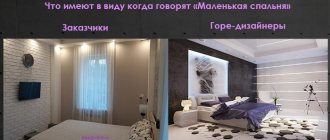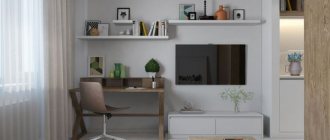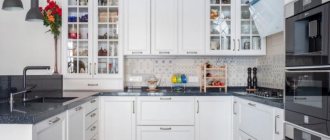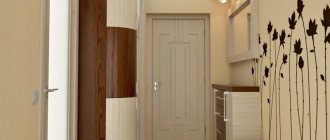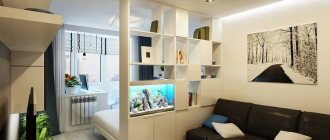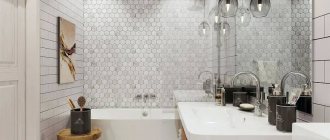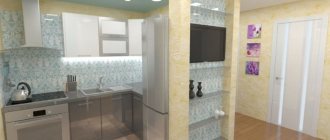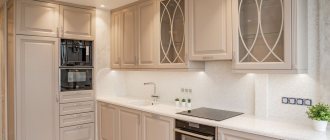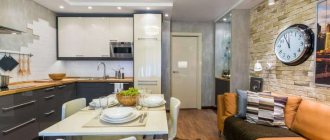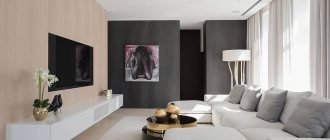The living room is the heart of the home and a meeting place for guests. This is a room in which any bold interior will be appropriate. Bright accent colors, custom textures and details are easily integrated into the guest area. An abundance of furniture is an optional condition for this room. A sofa, a couple of armchairs, a coffee table and a TV are a standard solution for a living room. Especially if the room has a small area.
In the standard layout, the living room is the largest room in the apartment. However, in old residential buildings, the largest room can have an area of 18 or even 16 square meters. In this case, it is important to approach the repair competently and take into account all functional areas.
It is important to work with zoning comprehensively. The color of the finish, type of flooring, protrusions, podiums, lighting and decorative elements will allow you to visually highlight the space and indicate its intended purpose. It is important to take these aspects into account already at the project creation stage.
Design Features
The living room can be either an isolated or a walk-through room. In the first case, it is possible to fully utilize the space and evenly place pieces of furniture in the room. When working with a checkpoint, it is important to consider the presence of several doorways. At the same time, it is worth providing space for passage. The main recreation area should be located in free space and highlighted with the help of lighting design, a podium or a multi-level ceiling.
In typical buildings, rectangular and square living rooms are most often found. In the first case, the elongated shape allows you to create a spacious interior that expands the space. In this case, it is better to place the main furniture near one of the walls of the room. It is better to refuse symmetry in such a space. The advantage of a square is that you can centralize the composition. The main furniture and recreation area are concentrated in a single space, while the corners remain free for other areas.
Redevelopment options
The simplest redevelopment solution would be to combine a room and a balcony. If the living room is combined with a loggia, it is enough to insulate it, glass it and remove the internal partition. This wall is not load-bearing, so it can be easily demolished if necessary.
However, if there is no balcony, it will not be possible to increase the living room area. In this case, the main redevelopment will be carried out inside the room. However, even with the original 18 squares, you can create an unusual and multifunctional interior. This can be done through zoning.
Floor finishing
The floor design chosen is:
- Parquet board or laminate;
- Cork.
To increase the space, the slats are laid diagonally, but this method will require a lot of material or time, so they prefer to decorate the living room in a more familiar way, with the short ends of the boards facing the window.
You can also use linoleum, but lately it has not been very popular due to its low environmental friendliness.
It is believed that the floor should be the darkest part of the finish, so when choosing light shades of the coating, the walls should be even lighter.
A carpet will be a beautiful addition to the floor, but, unlike the last century, such an element is not an indicator of wealth, so more and more young homeowners are refusing such a dust collector.
Zoning options for living room 18 sq.m.
Zoning the space will help create several functional zones. For example, in an old two-room apartment, the living room can serve as both a common room and a sleeping area or a study. In this case, it is worth allocating space. This can be done in different ways:
- With the help of color, light and texture, you can easily emphasize different functional areas. In this case, you will not have to install additional partitions - the design will visually isolate part of the space. It is best in this case not just to change the color scheme, but to use a non-standard style solution.
- Shelving not only serves as storage space, but also perfectly zones the space. At the same time, they do not take up much space and do not create a feeling of overload.
- Additional partitions are a more radical solution. This will not help with sound insulation, but will create the feeling of a separate corner. Partitions will help to separate zones of different functionality, for example, a living room and a bedroom.
- Curtains perform the same function as curtains, but they look less massive. Such an accessory will fit into the interior of different styles, add comfort to the atmosphere and at the same time help to highlight the area.
- Podiums help divide the space. Most often they are used to highlight an office or the main guest area.
The choice of a specific zoning method largely depends on the purpose of the zones and the general style of the interior.
Studio interior design
To save space, it is recommended to use transformable furniture on 18 square meters. When designing a bed, a lifting mechanism for the bed is often used: underneath there is a wardrobe for storing things.
To turn a bedroom into a living room, many owners install a transformable bed: during the day it is a sofa with a hanging shelf, and at night it is a full-fledged place to relax. A simplified option would be a folding sofa book.
Ideal option for a studio of 18 sq. m. – high ceilings. This gives more opportunities for arranging a living room, work area or even a children's corner. An excellent solution for this is a loft bed, which turns into a comfortable sleeping place.
The photo shows a bright kitchen combined with a living room. Upstairs is a hanging bed, which is used only at night.
Set up a studio of 18 sq. m. can be so that there is enough space for both a small sofa and a bed, but in this case the kitchen will become part of the “living room”. Zoning can be done using a glass partition, textiles or shelving.
In order not to overload the space of a cramped bathroom and hallway, it is recommended to abandon decorative elements that split the space (patterns in decoration and an abundance of textures). It is better to use closed cabinets to store household products and clothes. Designers also advise installing minimalist doors without frames.
In the photo there is a studio of 18 sq. m. in light colors, bathroom and toilet, tiled with white glossy tiles.
Style selection
In a small living room you can create an interior in many styles and even create an original mix. However, when developing an idea, it is important not to forget that an abundance of details will overload a small space. It is better to avoid a large number of decorative items and textiles, but this does not mean that any experiments are prohibited on 18 squares.
For example, a modern interior style will look great in a small living room. A laconic and functional solution will add air to the space. It is best to choose a light color scheme for this. Bright details will look great as accents in such an interior.
A classic solution will create a more sophisticated atmosphere. At the same time, the abundance of white will help expand the space. In a classic-style living room, solid wooden furniture, plant drawings, figurines, paintings, candles and indoor plants will look good.
A more casual and relaxed loft will add a touch of modernity to the space. This is a budget style that will look great not only in the main living room, but also in the office or sleeping area. In this case, finishing materials can become zoning elements. Brickwork or tiles will emphasize the isolation of the space without creating a feeling of overkill.
Lovers of natural materials will love the Provençal style. If the lighting of the room allows, you can choose a more subdued color scheme for a living room in this style: gray, olive or ocher. Furniture made from natural materials in light shades will help compensate for the rich color of finishing materials and create an unusual contrast.
Another solution for small spaces is minimalism. Such a living room should be dominated by smooth lines, a calm beige and light palette, simple materials, mirrors and tulle. In this case, all the main furniture should be placed at one point in the space, leaving the rest of the room free of unnecessary items.
Finishing Touches: Living Room Furniture and Accessories
Just a few years ago, the most popular option for furnishing an apartment in a panel house was to place all the items along the walls. And today this option still remains in demand, primarily because it saves space. But you can do it differently. So, if the space allows, create an accent in the center by placing a sofa and armchairs in the middle of the living room. Or you can try using furniture for zoning.
Stylish living room in high-tech style
What items can and should be used for furniture? A mandatory attribute is a sofa, which can be complemented with armchairs. You may need a table. A modern and multifunctional TV stand would be appropriate in the television area. It is better to store things in a closet; you can place books on a rack, and arrange accessories on shelves.
Walk-through living room
Don't forget about accessories, without them the design will not be stylish and interesting. Feel free to hang pictures on the walls, choosing them taking into account the style of the room. The figurines will look interesting on the shelves. The interior can also be complemented with textiles:
- carpet in the center of the floor;
- stylish curtains;
- luxurious bedspreads.
Flowers will make the room more comfortable, and they can be placed in almost any plane: not furniture, walls, on the floor and even under the ceiling. And modern accessories can also be functional, so pay attention to a variety of creative stands, holders, and so on. The living room in a panel house will definitely become cozy and comfortable if you show your imagination and follow simple rules when creating its design.
Did you like the article? Share on social networks!
Lighting
Since the living room is the central room in the apartment, you can experiment with lighting in this space. Properly selected artificial light will add comfort and warmth to the interior. As the main source, you can choose a massive chandelier with or without pendants. It will become the central accent of the space, which will visually help to assemble the style of the room into the overall picture. If the apartment has high ceilings, such a chandelier will additionally work to correct the space. A large object on a high ceiling with a small room area will give a visual match to the height and footage of the room.
Those who prefer more laconic lighting should opt for spotlights. They can be placed centrally or around the perimeter of the room. Such a lighting source can be either primary or additional. With its help you can easily zone the space.
Sconces and floor lamps will add coziness to the space. Spotlights will rid the room of dark corners. However, such light sources will not look harmonious in every interior: it is difficult to integrate such lighting devices into a space in a modern style or in a minimalist design.
If necessary, several light sources can be placed in the room: main and auxiliary. In this case, it is worth installing separate switches in each zone. In addition to electrical appliances, it is worth considering the placement of mirrors and glossy surfaces in the room. Glare caused by light rays can cause discomfort.
Ceiling
Interior styles, no matter what you choose, have the same requirements for the ceiling. If the ceilings are low, then visually they can also be made higher.
There are a number of techniques for this: Use several colors when decorating the ceiling. For a solid ceiling, use a glossy surface. Use mirrors only on part of the ceiling.
Avoid a large chandelier and use small details in lighting. The ceiling should be lighter than the floor and walls
